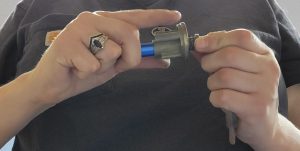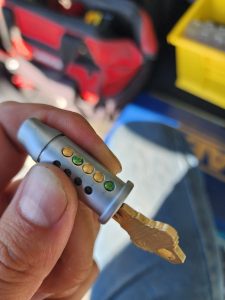As we mentioned in our last blog, rekeying locks (or trying to “Change locks”) is a process to change the internal pins of a lock so that it can work with a new key. If you haven’t read our previous blog, you can do so here: https://katzlocksmith.com/blog/locks/rekey-or-replace-what-do-you-choose/
Rekeys are commonly done to increase security or when there’s a need to grant or deny access without replacing the entire lock mechanism. Rekeying also becomes necessary when pins and springs wear out. Frequently with these rekeys, home or business owners will keep the same key.
Here’s a general overview of the steps involved in rekeying a typical pin-tumbler lock:
- Remove the Lock Cylinder: To rekey the lock, you first need to remove the lock cylinder from the door or lock assembly. This usually requires taking apart the lock and/or using a specific tool to extract the cylinder.

Removing plug from housing - Remove Plug/Core from Housing: This usually requires removing a small C-clip and using a plug follower. There are many different types to match different lock types. Keep in mind, if this is done incorrectly, you usually will end up needing to replace top pins and springs. Ask me how I know.
- Take Out the Old Pins: Once the cylinder is out, the old bottom pins and if necessary, the top pins and springs that correspond to the old key are taken out of the cylinder plug.
- Insert New Pins: Now, new bottom pins (and sometimes top) pins, corresponding to the new key, are inserted into the cylinder plug’s holes. The length of the pins should match the new key’s bitting (the pattern of cuts and grooves on the key). Trust me, needing to pick the lock without ripping it out of the housing because the pins didn’t line up quite right is not fun. If you’re master keying, make sure all keys are working properly!

- Insert the New Key: The new key is used to reinsert the core into the lock’s housing. Check how well the key turns before removing… Carefully.
- Reassemble the Lock Cylinder: After confirming that the new key operates smoothly in the lock, the lock is reassembled back into the housing .
- Test the New Key: Test the newly rekeyed lock with the new key to make sure it works as expected and that the old keys no longer function. it is strongly suggested that you keep the door open for initial testing. Nothing worse than locking yourself out trying to test your new keys!
Rekeying locks can be a cost-effective way to maintain security when there’s a change in occupancy (for example, moving into a new house) or when keys are lost or stolen. It’s typically a job for a professional locksmith, although some lock manufacturers provide rekeying kits that allow homeowners to rekey their locks themselves. However, it requires some level of skill and knowledge, so if you’re unsure about how to do it, it’s best to seek the help of a professional locksmith to avoid damaging the lock or compromising its security.
Katz Locksmith is a full-service company that specializes in commercial locksmith work. We are family and woman-owned, and we’re committed to providing great service! We service businesses in areas such as Eastvale, Claremont, Corona, Fontana, Glendora, Montclair, Ontario, Rialto, San Bernardino, Upland, and more! We go into mountain area such as Mt. Baldy, Crestline, and Big Bear. For additional information or booking a service call us @ (909) 942-0282.